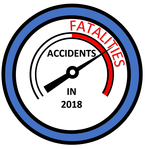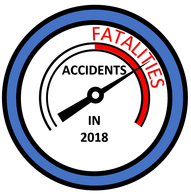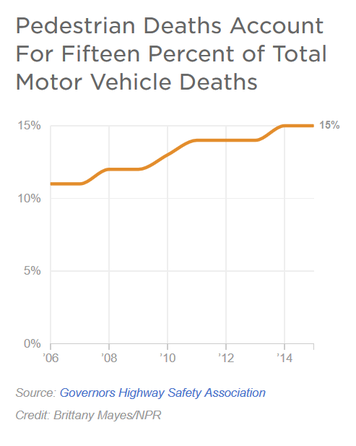Bike and Pedestrian Fatalities Higher than Ever in USA. Current Methods of Safety Not Working to Reduce Fatalities
If there are 37,000+ vehicle related deaths each year in the USA, and Pedestrians account for 15% of these, and they used to be only 11%, then this 4% increase represents 1,500 MORE pedestrian deaths each year compare to just 10 years ago. The 37,000+ number is also at a peak.
Obviously, whatever is the mainstream safety push for transportation is not working to even bring down the number of fatalities each year in the USA, in fact, it is going the opposite direction. Current methods are clearly not working and should be reconsidered as a whole. Nobody quite understands this counter-intuitive result, but the Governor's Highway safety Association is aware of it. Here is what they are saying: "IT IS ALARMING," says GHSA* executive director Jonathan Adkins, "and it's counter-intuitive." (*Governor's Highway safety Association).
We need to pay attention to the facts, the accident history. "There's been an assumption that, because of increased safety of vehicles as we move toward semi-autonomous vehicles, that traffic deaths were going to go down," Adkins says. "We're seeing just the opposite, unfortunately, with a particular spike as it relates to pedestrians and cyclists."
from NPR's Pedestrian Fatalities Remain At 25-Year High For Second Year In A Row:

New traffic methods for PEDS/Bikes have not moved the needle. They LOOK good, but... Cycle Tracks and XWalks are not solving it. PED bridges are not cutting the fatalities (UP! to 40k / year in USA) ...no improvements! "Vision Zero" as currently envisioned seems beyond reach. We need new Engineered & real solutions that will eliminate mixing of vulnerable travel modes with vehicles. J-Walkers, PEDS crossing paths with vehicles, cyclists mixing with cars/trucks assuming safety, while traveling along side some incompetent or risk-taking drivers: HUMAN factors... and not Improving.
The assumption that any kind of "new and improved" traffic control device specifically for PEDS or BIKES will make them safer needs to be questioned, since the accident fatality data does not bear this out. The needle has been moving in just the opposite direction, and we can no longer assume that more striping, different striping, or even complete streets will make pedestrians safer. What needs to happen is a realization that MORE pedestrians mingled with Vehicles on roadways where cars/trucks can hit people directly, is turning out to be a dangerous thing.
0 Comments
|
AuthorGrant Johnson, registered Traffic Engineer, shares insights and experiences from around the world. Archives
June 2023
Categories
All
|


 RSS Feed
RSS Feed